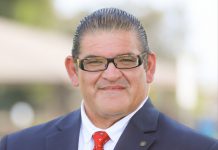In August 2020 a group of faculty, students and community members approached the Cabrillo Board of Trustees and stated that the college’s namesake, the 16th-century navigator and explorer, Juan Rodriguez Cabrillo, was no longer appropriate to be on the college. He represented, they said, the worst of Spanish colonialism in California.
The Board of Trustees set up a subcommittee, the Name Exploration Committee, to explore the issue. The subcommittee has been gathering opinions these past two years and is scheduled to issue its recommendation whether to remove the Cabrillo name at the coming board meeting on Nov. 14.
The full Board of Trustees can then accept the recommendation or not.
In an effort to balance the process I was asked to relate how the college was named “Cabrillo College” in 1959.
I will say at the outset that the selection of the name Cabrillo for the college had little to do with the historical person, and most to do with the fact that the person and the name meant nothing to most county residents in the 1950s.
For almost 50 years, the factions in the county had dickered and dawdled about establishing a taxpayer-supported junior college. The issue was first put before the voters in 1954 in a countywide election. The voters slammed it down with a 70% vote of no. This newspaper ran an ominous headline: “Junior College Killed.”
But, the need for a more accessible and inexpensive junior college continued. To get an education beyond high school, this county’s young people had to “go away to college.” Once educated they often didn’t return. The county’s future was bleeding away.
In October 1958, the county’s educators scheduled a second junior college election and with a brilliant campaign they completely reversed the vote—70% voted yes.
In the late 1970s and early 1980s I went all over the county and interviewed all the participants in that second campaign and asked them, “How did you do it?”
Their responses were almost unanimous—they made three promises to the voters. If the junior college was approved:
1. The college would not belong to any particular place in the county and thus would be in a neutral site, most often articulated as “somewhere between Santa Cruz and Watsonville.”
2. The college would have a name that had no connection or meaning within the county.
3. The campaigners would run for election to the Board of Trustees to guarantee that the first two promises were kept.
With those agreements made, the factions laid down their swords, voted for the junior college, and then watched and waited for the promises to be kept.
They were. The new Board was almost all campaigners, and at their first meeting on May 2, 1959 they unanimously approved the name “Cabrillo College.” In astonishing speed, they hired their top administrators and faculty, rented classroom space at Watsonville High School and opened their doors in September.
Why Cabrillo? Partly because in 1957, the State Legislature had brought the name into the county when it named Highway 1 The Cabrillo Highway.
Nobody ever used the name (and still don’t) but it fit the definition of having no connection to the history of this region. And it was lying alongside the highway that connected Santa Cruz and Watsonville.
In 1959 the name “Cabrillo” was an empty vessel, but not for long. It became a symbol of the freshly unified county. The name was part of the connective tissue holding the county together in a common cause.
The college’s first referendum came less than a year after it opened its doors. In June 1960 county voters gave an 80% favorable vote to the then-largest bond issue ever proposed in the county. Yes, the voters said, we like what we are doing.
With that money, using almost entirely local contractors, they built a shining award-winning campus overlooking the sea. And with the power of education and culture transformed this tiny backward little county into the educational powerhouse it is today.
A child born in this county, with the requisite focus and resolve, could advance all the way from kindergarten to a PhD and never leave the county.
If you have an opinion either way about whether or not Cabrillo College should remove the name “Cabrillo,” please contact the Name Exploration Committee at Cabrillo College. It is your college, after all.
Sandy Lydon has been a teacher and historian at Cabrillo College since 1968. He will be continuing the history of the college and celebrating the 60th anniversary of the main campus in one of his legendary lectures on Oct. 28 from 7-10pm on the Aptos campus. To register, visit extension.cabrillo.edu or call 479.6331.











